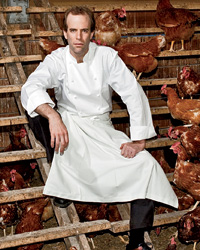Dan, how can we bring the locavore movement to medium-priced restaurants?
Dan Barber: It’s a hard one. It is about making choices, and changing your menu often, maybe daily. Buy the whole lamb, use all the parts and there will be a savings overall. But that means you cannot serve loin of lamb every night.
Over the past century, most industrialized nations have transformed from having a majority of the population working the land to a minority. One of the bigger challenges to being able to feed most of the population with sustainably-grown food seems to be that we’ll need a larger farming workforce. How can we address this issue?
Stone Barns: You are absolutely right, we will need many more people to be involved in the food system, either as producers or active food citizens. At Stone Barns, we are working to train the next generation of farmers in sustainable practices. There are a tremendous # of entrepreneurial people interested farming as a career, some who are generations removed from working the land. Chefs Make Change donations go to support this work. It’s also about all of us being active food citizens—from what we buy, to asking for this kind of food in our restaurants, markets and schools.
Is there any reason why an “heirloom” tomato should cost $7/lb when a standard tomato in the same market (also locally grown) costs $2/lb?
SB: Some of it may be perceived value, but heirloom crops can be challenging to grow. With tomatoes, we might lose as much as 30 percent of the crop to breakage, bruising, etc. We’re working with seed breeders on hybrid varieties that will have both great flavor and nutrition, and a bit more resilience.
DB: And if cooks, at home and in the restaurant, would be willing to purchase the bruised and less then beautiful tomatoes to make sauces or tomato water, the farmers could charge far less.
How ascetic should we northerners be in the winter? For example, citrus is such an important element in the kitchen and I have to admit that some of the organic blueberries coming from Chile are quite tasty.
DB: I’m not a purist—we use plenty of citrus in winter. (And I don’t feel guilty about buying it.) But I draw the line at blueberries in January. I’d rather wait for when the local berries arrive in June. Then I eat them by the pint.
San Marzano tomatoes are so expensive, and I would like to use some of the local tomatoes anyway. What are comparable paste tomatoes that can be grown in the US?
DB: Try to find Jersey Fresh—delicious. It is a crushed product, but cold be substituted in some recipes.
What are some of your favorite ways to eat locally in the winter?
DB: I hear a lot of complaints about farming (and eating) in the Northeast at this time of year, but the climate is perfect for root vegetables. In the cold weather, the vegetables convert their starches to sugars in order to survive, so we get the sweetest possible carrots and turnips. As far as techniques go, we just got a new grill, and we’ve been having some fun with that.
SB: If you have a backyard you can put up a very simple covered, low tunnel structure to grow spinach, mache & kale. Check out this video of winter on our farm and harvesting in these tunnels.
I was wondering where you find inspiration when having fresh vegetables is kind of limited?
DB: This year, we made a big push for preserving, and it’s been a great way to make it through the winter doldrums. But the things I’m most excited about take advantage of the cold—like the crop of overwintered parsnips Jack Algiere planted last March that he’ll harvest next month, or the ice spinach growing outside in winter tunnels.
What I should look for when selecting an heirloom tomato at a farmer’s market in the summer?
DB: Well, Jack just said, “tell her not to squeeze it, the price will only go up more.” The only way to know is to taste them. Heirlooms have such a variety of flavors—from the sweet to tart.
What are some of your favorite restaurants across the country?
DB: As far as restaurants go, maybe Oleana in Cambridge or Husk in Charleston? Those have been some of my favorites this year.
Favorite dessert?
DB: Apricots, straight from the fridge.

Chef Dan Barber. Photo © Andrew Hetherington.
No comments:
Post a Comment